
From medieval hilltops to breezy coastlines, European wine towns make for irresistible vacation spots. Local cuisines help form a food-wine symbiosis unique to each locale, and surrounding vineyards provide the perfect backdrop. Whether renowned or under the radar, these gastronomic playgrounds offer plenty to taste plus enough history and culture for days of exploration. So head down into the cellar, uncork a prized vintage or two, and toast to these 10 amazing European wine towns.
Image Gallery
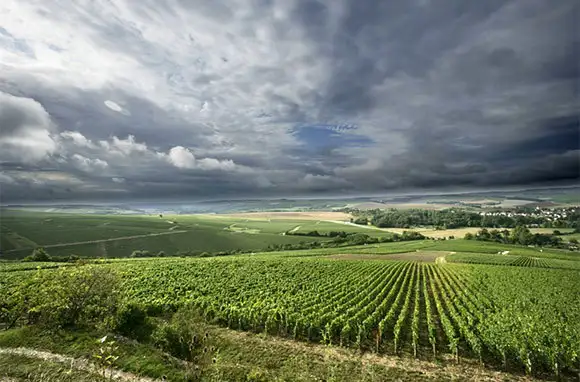
Beaune, France
Within its ramparts and narrow cobblestone streets, Beaune has one major priority: the production—and consumption—of wine. Dubbed the wine capital of Burgundy—itself one of the most famous viticulture regions in all of France—the small town has been obsessed with the drink since the Middle Ages, thanks in part to the lavish lifestyles of the Dukes of Burgundy. Today, it remains the region's center for wine trade and tourism. As you walk through town, undoubtedly in search of prestigious Pinot Noir-based vintages, stop at the Wine Museum, the Dukes' former residence, for a quick study in oenology, then enter the cellars at Marche aux Vins for a free tour and tasting. Across the way, the Hotel-Dieu, a medieval charity-hospital museum that hosts an annual wine auction every November, offers a sobering look into the lives of the sick and poor in the 15th century.
Uncork: Biodynamic wines at Joseph Drouhin, best tasted in the winery's historical Duke's cellar, built on top of 4th-century Roman fortifications.
Pair: In the snazzy, red-cloaked dining room at Loiseau des Vignes, opened in 2007 by Dominique Loiseau (wife of late chef Bernard Loiseau), choose from among 70 different wines by the glass to accompany the regional prix-fixe menu.

Beaune, France
Within its ramparts and narrow cobblestone streets, Beaune has one major priority: the production—and consumption—of wine. Dubbed the wine capital of Burgundy—itself one of the most famous viticulture regions in all of France—the small town has been obsessed with the drink since the Middle Ages, thanks in part to the lavish lifestyles of the Dukes of Burgundy. Today, it remains the region's center for wine trade and tourism. As you walk through town, undoubtedly in search of prestigious Pinot Noir-based vintages, stop at the Wine Museum, the Dukes' former residence, for a quick study in oenology, then enter the cellars at Marche aux Vins for a free tour and tasting. Across the way, the Hotel-Dieu, a medieval charity-hospital museum that hosts an annual wine auction every November, offers a sobering look into the lives of the sick and poor in the 15th century.
Uncork: Biodynamic wines at Joseph Drouhin, best tasted in the winery's historical Duke's cellar, built on top of 4th-century Roman fortifications.
Pair: In the snazzy, red-cloaked dining room at Loiseau des Vignes, opened in 2007 by Dominique Loiseau (wife of late chef Bernard Loiseau), choose from among 70 different wines by the glass to accompany the regional prix-fixe menu.

Bernkastel-Kues, Germany
Of the many wine villages on Germany's Mosel River, Bernkastel-Kues is one of the most well-known and oldest. Set in the Middle Mosel region, the town has the ideal terroir for growing prized Riesling grapes. Its steep, slate-covered hillsides are striped with vineyards and lead up to the ruins of Landshut Castle, a focal point for cruisers floating by in river boats below. In the town center, take time to admire the medieval market square lined with half-timbered houses, and stop to photograph the narrow and leaning Spitzhauschen ("Pointed House") that dates back to 1416. Continue on, strolling through small boutiques and breaking for a leisurely lunch at one of the many welcoming restaurants. Just be sure to open a bottle of the town's most legendary wine, Bernkasteler Doctor, which supposedly cured the 14th-century Archbishop of Trier of serious illness.
Uncork: More than 160 regional wines—including Riesling, sparkling Elbling, and fruity Kerner varietals—at the Mosel Wein Museum's Vinothek, housed in the cellars of the historical St. Nicholas Hospital.
Pair: Enjoy regional specialties complemented by a Riesling-focused wine list at Doctor Weinstube, a 17th-century hotel and tavern with an inviting, rustic dining room.
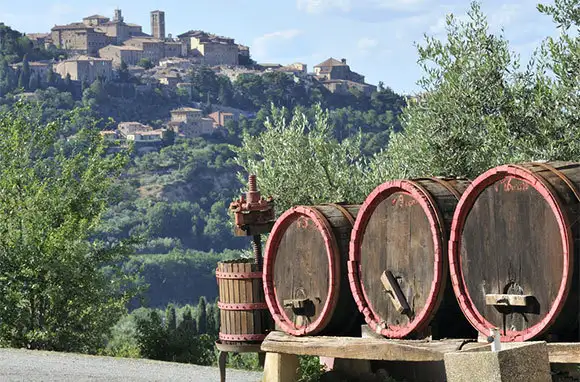
Montepulciano, Italy
Perched above vineyards and cypress-tree groves in the Italian province of Siena, Montepulciano is the biggest and highest medieval hill town in southern Tuscany. Panoramic views of the Val d'Orcia countryside render it a perfect setting for movies like The English Patient and Under the Tuscan Sun, but it is most famous for its Vino Nobile di Montepulciano, a red wine made primarily from Sangiovese grapes. The town, lined with Renaissance palaces and churches, centers on Piazza Grande, where the Bravio delle Botti barrel race takes place every August. Food lovers will especially enjoy shopping in the Centro Commercial Naturale, visiting the olive mill, and learning how to make pici pasta with flour from local wheat at the Il Sasso school for language and culture.
Uncork: The celebrated reds at the Consorzio del Vino Nobile di Montepulciano, the local wine consortium made up of more than 70 producers, and its Enoteca Wine Shop in the historical Palazzo del Capitano on Piazza Grande.
Pair: Sample Pecorino cheese, meat, honey, and olive oil in the town's cantines (wine cellars), which are often linked by underground tunnels. Local favorite Cantine Contucci, in the 13th-century cellars of the Palazzo Contucci, is open for tastings every weekday.
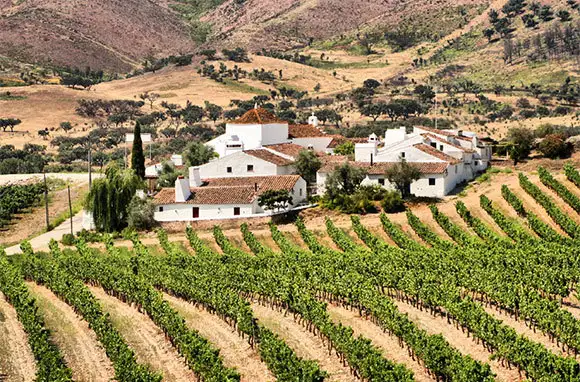
Borba, Portugal
When in Portugal, many wine lovers make a beeline to Porto and the Douro Valley. However, the lesser-known Alentejo region to the south has plenty to offer as well, especially when it comes to smaller towns devoted to wine. Though the historical UNESCO World Heritage city of Evora has a regional tasting room and is a natural starting point for the Alentejo wine route, it's nearby Borba that truly lives for wine. From adegas (wineries) in the heart of town to the annual Festa do Vinho e da Vinha (Festival of Wine and Vine) in November, visitors to Borba have plenty of opportunities to sample its robust reds. However, it's also worthwhile to check out the architectural details throughout town: Because of several nearby quarries, Borba is dressed in fine marble, particularly at sites like the Convento das Servas de Cristo and the ornate Fonte das Bicas fountain.
Uncork: Touriga Nacional (considered Portugal's finest grape) along with other regional varietals such as Trincadeira and Aragonez at Adega de Borba, a cooperative that offers different labels from 300 wine-growing associates.
Pair: Dine among giant terra-cotta talhas storing wine while eating local specialties—including ensopado de borrego, a lamb stew, and migas, a traditional dish usually made with breadcrumbs, garlic, and pork—at tasquinhas, or small taverns and restaurants, in town.
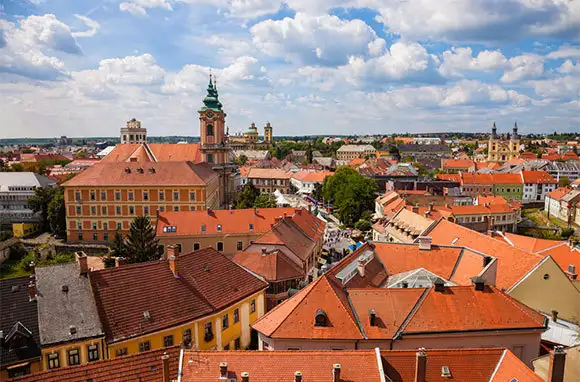
Eger, Hungary
On the hills of the Bukk Mountains, nestled in one of Hungary's main viticulture regions, Eger is a popular wine town regarded for its whites and especially reds. Architecturally, the town presents a melange of Turkish, Baroque, and neoclassical styles, evident in well-touristed sites like the Eger Cathedral and the original Ottoman-period minaret. You can learn about the history of Eger's castle and its underground fortification system at the Istvan Dobo Castle Museum, then unwind (releasing any lingering anxiety from the museum's medieval-punishment exhibit) at the recently renovated thermal baths and Turkish spa. After climbing the 97 claustrophobic steps of the needle-shaped minaret, get a sweet fix at the Marzipan Museum and candy shop across the way. To taste wine, hop on the shuttle from the central Dobo Square to cellars in Szepasszony-volgy, or "Valley of the Beautiful Women," just south of town.
Uncork: The legendary Egri Bikaver, or "Bull's Blood of Eger," Hungary's best-known wine internationally. Blended with three or more red grapes—primarily Kekfrankos—the cuvee is matured in oak barrels for at least a year.
Pair: Taste dishes such as goulash soup, roasted pork tenderloin with creamy wild mushrooms, and smoked Hungarian sausage at Kodmon Tavern, an elegant spot that has been serving local cuisine since 1778.

Haro, Spain
With clay soil ideal for growing grapes, multitudes of wine bodegas, and an organized vineyard route, Haro has earned the right to be called the wine capital of Spain's Rioja region. Not only does wine drive Haro's local economy, but it is also taken quite seriously as a way of life—so much so that on the feast of San Pedro (June 29), the town hosts a wine battle, during which opposing sides launch liters of wine at each other, then throws an after party in central Plaza de la Paz Square. Oenophiles and casual visitors alike can delve into the study of viticulture at the Rioja Wine Interpretation Centre, which serves as a research center and museum, or taste the area's fine red wines at the many vineyards and cellars open to the public.
Uncork: Wines from area bodegas, such as the generations-old Lopez de Heredia or the more modern Roda, which specializes in Tempranillo-based wines.
Pair: In Haro's Herradura neighborhood, known for tapas bars and restaurants, seek out dishes like pepitos (steak sandwiches) or pincho moruno (skewered diced pork). For traditional cuisine, mixed vegetable stew, chorizo, and lamb cutlets with vine shoots go nicely with the local wines.
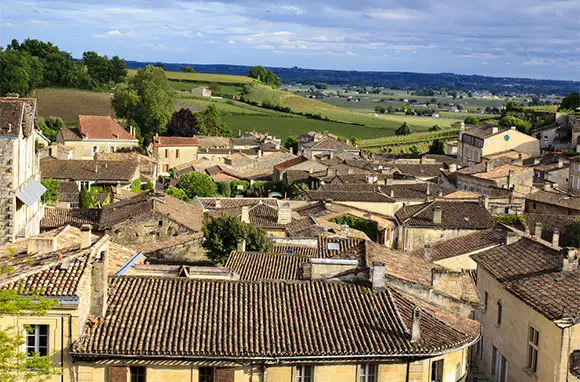
Saint-Emilion, France
If the scent of freshly baked macarons wafting through medieval streets isn't enough to lure you into Saint-Emilion, the wine certainly will. One of the most famed villages on the right bank of France's Bordeaux region, Saint-Emilion is built as much on Merlot and Cabernet Franc as it is on ancient limestone. After visiting the many wine shops in town, take a tour of the 800-year-old Monolithic Church and go underground to the cave where Breton monk—and hermit—Emilion once lived. Come back up to admire the eye-catching 173-foot-high bell tower before following the winding road that leads out to wine-tasting chateaux and rows of vineyards in a World Heritage landscape that span as far as the eye can see.
Uncork: Wines by innovative—but controversial—garagiste winemakers, such as Chateau Valandraud and the appropriately-named Bad Boy label by Jean-Luc Thunevin.
Pair: Decant a bottle of Grand Cru Classe then toast to seasonal market cuisine either indoors or on the shaded terrace at L'Envers du Decor.

Orebic, Croatia
On the southwestern tip of Peljesac, a peninsula on Croatia's Dalmatian coast, Orebic is a maritime town that attracts tourists looking to relax on its sandy beaches, dine on the local catch, and drink wine from the surrounding vineyards. Explore the Maritime Museumâand its collection of models and paintings of boatsâat the foot of Mount Elijah, and find sea captain's homes (which you can often stay in) throughout town. The Franciscan monastery's observation towers afford views of the Adriatic, the old town below, and the fruit trees, cypresses, and olive groves that dot the landscape. Winemaking on Peljesac dates back to Roman times, and the Plavac Mali grape, called "the blood of the soil" in Dalmatia, thrives in the Mediterranean climate and takes center stage on the peninsula's pebbled hills.
Uncork: Dry, ruby-red wines such as Dingac, which is deeply rooted in the region's winemaking tradition and became Croatia's first protected wine, and Postup, the country's second protected wine.
Pair: In Orebic's taverns and cafes, seafood reigns supreme. The highlight is the local shellfish, in particular crab, squid, and octopus, but leave room for the region's handmade cured ham and cheeses, local olive oil, and fresh citrus fruits and vegetables.

Barolo, Italy
Barolo, famous for its garnet-colored wines made from the Nebbiolo grape, is a low-lying town tucked into a valley in Italy's hilly Piedmont region. While the town has produced wine since at least Roman times, we can thank the last Marchessa of Barolo, French-born Giulia Colbert Falletti di Maulevrier, for realizing the potential of the noble grape in the mid-19th century and getting the town on the map. Visit her former home, the recently renovated Castello Falletti, which houses the WineMuseum (or WiMu) and tasting room, or head next door to the Corkscrew Museum in a former wine cellar. Stay in the neighboring countryside and use your rented villa or farmhouse as a home base for taking walks through the vast vineyards of Barolo and the rest of Piedmont's Langhe wine region.
Uncork: Wine from the 11 communes that produce Barolo at Enoteca Regionale del Barolo, located in the basement of the Falletti castle.
Pair: Choose dishes that can stand up to—and are often cooked in—the region's wine, such as mushroom risotto, braised beef, and gamey stews like bollito misto. Find similar items on the menu at Locanda nel Borgo Antico, a modern farmhouse restaurant tucked away in the vineyards.

Pico (Madalena), Portugal
It's one thing to be a wine town, but it's quite another to be a wine island. On the Azorean isle of Pico, coastal vineyards grow along the sloped edges of an enormous volcano, with their gnarled grapevines creeping up basalt stone walls that protect the plots, or currais, from whipping sea winds and saltwater. Get an introduction to this unusual World Heritage vineyard landscape at the wine museum in Lajido, then trail the coastline in search of clay-roofed wine cellars built with black lava rock, old stone ramps (rola-pipas) that barrels would roll down and onto waiting boats, and tracks (rilheiras) carved by ox carts hauling grapes over the rugged landscape. At the cooperative in the main town of Madalena, learn how the basaltic wines are crafted and, of course, taste them too.
Uncork: Regional whites and reds from Frei Gigante and Terras de Lava, plus aperitif wines and firewater, which will knock you clear off your axis if you're not careful.
Pair: At Restaurante Ancoradouro in Madalena, start by drizzling corn bread and Pico cheese with honey, then pair a glass of vinho branco with any one of the seafood specialties. Grab a table on the breezy terrace for views of the sea and the nearby island of Faial.
More From Smartertravel:
We hand-pick everything we recommend and select items through testing and reviews. Some products are sent to us free of charge with no incentive to offer a favorable review. We offer our unbiased opinions and do not accept compensation to review products. All items are in stock and prices are accurate at the time of publication. If you buy something through our links, we may earn a commission.
Related
Top Fares From
Today's Top Travel Deals
Brought to you by ShermansTravel
Greece: 9-Night Vacation, Incl. Meteora &...
Exoticca
 vacation
$2099+
vacation
$2099+
New Year Sale: Luxe, 9-Nt Alaska...
Oceania Cruises
 cruise
$3599+
cruise
$3599+
Ohio: Daily Car Rentals from Cincinnati
85OFF.com
 Car Rental
$19+
Car Rental
$19+



